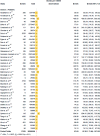Age-specific global epidemiology of hydrocephalus: Systematic review, metanalysis and global birth surveillance
- PMID: 30273390
- PMCID: PMC6166961
- DOI: 10.1371/journal.pone.0204926
Age-specific global epidemiology of hydrocephalus: Systematic review, metanalysis and global birth surveillance
Erratum in
-
Correction: Age-specific global epidemiology of hydrocephalus: Systematic review, metanalysis and global birth surveillance.PLoS One. 2019 Jan 10;14(1):e0210851. doi: 10.1371/journal.pone.0210851. eCollection 2019. PLoS One. 2019. PMID: 30629693 Free PMC article.
Abstract
Background: Hydrocephalus is a debilitating disorder, affecting all age groups. Evaluation of its global epidemiology is required for healthcare planning and resource allocation.
Objectives: To define age-specific global prevalence and incidence of hydrocephalus.
Methods: Population-based studies reporting prevalence of hydrocephalus were identified (MEDLINE, EMBASE, Cochrane, and Google Scholar (1985-2017)). Preferred Reporting Items for Systematic Reviews and Meta-Analyses guidelines were followed. Two authors reviewed abstracts, full text articles and abstracted data. Metanalysis and meta-regressions were used to assess associations between key variables. Heterogeneity and publication bias were assessed. Main outcome of interest was hydrocephalus prevalence among pediatric (≤ 18 years), adults (19-64 years), and elderly (≥ 65) patients. Annual hydrocephalus incidence stratified by country income level and folate fortification requirements were obtained (2003-2014) from the International Clearinghouse for Birth Defects Surveillance and Research (ICBDSR).
Results: Of 2,460 abstracts, 52 met review eligibility criteria (aggregate population 171,558,651). Mean hydrocephalus prevalence was 85/100,000 [95% CI 62, 116]. The prevalence was 88/100,000 [95% CI 72, 107] in pediatrics; 11/100,000 [95% CI 5, 25] in adults; and 175/100,000 [95% CI 67, 458] in the elderly. The ICBDSR-based incidence of hydrocephalus diagnosed at birth remained stable over 11 years: 81/100,000 [95% CI 69, 96]. A significantly lower incidence was identified in high-income countries.
Conclusion: This systematic review established age-specific global hydrocephalus prevalence. While high-income countries had a lower hydrocephalus incidence according to the ICBDSR registry, folate fortification status was not associated with incidence. Our findings may inform future healthcare resource allocation and study.
Conflict of interest statement
The authors have declared that no competing interests exist.
Figures







References
Publication types
MeSH terms
Substances
LinkOut - more resources
Full Text Sources
Other Literature Sources
Medical
Miscellaneous

